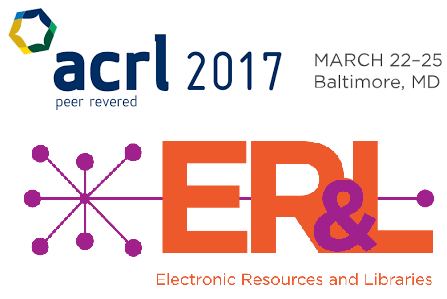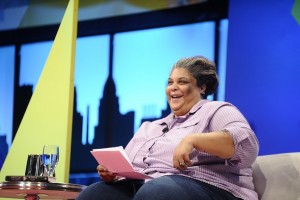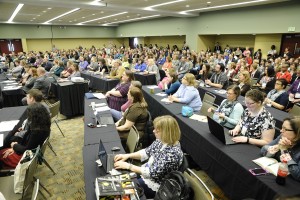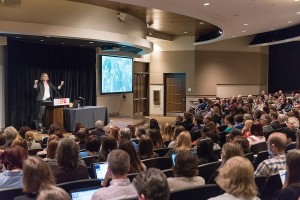Conference Catch-Up
The 2017 conferences held by the Association of College and Research Libraries (ACRL) and Electronic Resources & Libraries (ER&L), in March and April respectively, covered trends ranging from diversity to emerging technology.
 The 2017 conferences held by the Association of College and Research Libraries (ACRL) and Electronic Resources & Libraries (ER&L), in March and April respectively, covered trends ranging from diversity to emerging technology.
The 2017 conferences held by the Association of College and Research Libraries (ACRL) and Electronic Resources & Libraries (ER&L), in March and April respectively, covered trends ranging from diversity to emerging technology. ACRL 2017
The ACRL conference, held in Baltimore March 22–25, broke conference records for both attendance and fundraising. More than 5,200 academic library professionals, exhibitors, speakers, and guests were on hand—nearly 3,500 in person and more than 246 virtually, representing all 5 states and 31 countries. More than 1,320 of them were first-timers, another record.Library DIY
One strand of content very much in evidence was a do-it-ourselves spirit, pairing low-cost tech with invention to produce results unavailable, or unaffordable, through commercial offerings. These included Wisconsin-based Madison Area Technical College’s creative repurposing of Tutor Trac software, already in use in its writing center, to track outcomes of library instruction. The data was used to advocate with deans and cabinet members, resulting in both more budget dollars and formal recognition to get more buy-in. The next steps? Ensuring that the library is as effective for all students, and working with the vendor to develop a library-specific product. Meanwhile, the University of Houston–Clear Lake, TX, used eye-tracking software to rethink LibGuides. Working with a cognitive think-aloud protocol, in which test subjects explain their thought process as they go, librarians learned that a lack of size differentiation between headings and text, color choices, and the organization of the visual hierarchy were confusing students. Takeaways for future research include the desire to add a retrospective, in which the researchers watch video of the interaction with the students, and a quantitative analysis. In one of the most Maker-inflected projects, librarians at Virginia Tech built their own smart sensors and attached them to chairs in the library, adding low-cost components to tell how long students are sitting in chairs, if and when the chairs are moved, and when the device is being tampered with. The open source design is available for others to adopt and adapt.Equity, Diversity, and Inclusion

Keynote speaker Roxane Gay at ACRL
Photo credit: Laurie DeWitt/Pure Light Images
Advocacy in Action

Chair's Choice program at ACRL
Photo credit: Laurie DeWitt/Pure Light Images
ER&L 2017 Conference

Anna Lauren Hoffman's opening keynote at ER&L
The Electronic Resources & Libraries Conference (ER&L) in Austin, TX, April 2–5, offered attendees presentations and panel discussions on topics ranging from emerging technology to organizational strategies. Following a Sunday of preconference workshops, Anna Lauren Hoffman, postdoctoral scholar at the School of Information at the University of California, Berkeley, presented the opening keynote Monday morning: “Data Violence: Dignity, Discrimination, and Algorithmic Identity.” The collection of data and the use of algorithms to sort and evaluate people can generate virtual doppelgängers that bear little resemblance to the people they would purport to represent, sometimes to tactless and humiliating results, Hoffman explained. Citing a widely reported example from 2015, in which Google’s Photos app had tagged a photo of a black computer programmer and his girlfriend as “gorillas,” Hoffman noted, “It’s hard to quantify and capture the kind of harm that emanates from these moments.” In another example, a transgender woman was blocked from the dating app Tinder for “inappropriate behavior,” despite a clear bio and a profile photo in which she is carrying a large canvas tote bag reading “proud to be trans,” because so many men kept selecting her photo and then blocking her. And these are just examples of blatant indignities. Algorithm-driven systems are rarely designed with marginalized groups in mind, yet these “opaque and invisible models” can perpetuate bias and now shape everything from Facebook news feeds to hiring processes to Transportation Security Administration (TSA) screening procedures. However, Hoffman concluded on a positive note, these systems can be changed, and companies such as Tinder, Google, and Facebook have been willing to make adjustments when problems come to light.Budgets and OA

Vendor event at ER&L
Many academic libraries have been facing budget cuts, even as the cost of journals and other resources continue to rise. Dealing with this squeeze has become a regular topic at ER&L. Facing a $500,000 budget cut (17 percent) for FY17, the University of Wisconsin, Milwaukee, library was forced to consider breaking up its “big deal” subscriptions, librarian Mitchell Scott explained during his Monday “short talk” presentation. Three electronic journal packages—from Elsevier, Springer, and Wiley—accounted for a third of the library’s collection budget. Following an analysis of average uses per title and interlibrary loan (ILL) requests for subscribed package content, the library ultimately broke up the Springer and Wiley big deals, subscribing individually to journals that received an average of at least 150 uses per year and planning to have ILL and “Get It Now” from the Copyright Clearance Center provide access to less frequently used publications. In the same session, Caroline Mills of Furman University, SC, discussed how her library, in 2007, identified 60 underused journal titles that together cost $170,000 per year and migrated to a mediated pay per use model for those journals the following year. Mediation, however, recently began taking too much staff time, so the library enabled unmediated access for faculty and students via Get It Now. There were some initial concerns about the potential for cost overruns, and occasionally people do waste money by using the service multiple times to access the same article, rather than downloading it once. But Mills noted that in FY16, Furman spent almost $96,000 on pay per use articles from 865 unique journals, which compares favorably to the $170,000 the university was spending on 60 underused titles a decade earlier. In a separate session, Kevin Garewal, University of Akron, and Richard Wisneski, Cleveland State University, discussed a cooperative collection management strategy that their university libraries had been pursuing owing to significant budget cuts at both institutions. Anna Dabrowski, Eric Hartnett, and David E. Hubbard, all from Texas A&M University, College Station, discussed the success of their Open Access to Knowledge Fund (OAKFund), which encourages faculty to submit articles to peer-reviewed, nonhybrid open access journals by underwriting article processing charges of up to $3,000. Established in September 2013, OAKFund initially had a budget of $25,000 from the library, with an additional $20,000 in matching funds from the office of the vice president for research. It has grown to $85,000 for FY16/17. Monica Bulger, leader of the Enabling Connected Learning Initiative at the Data & Society Research Institute in New York City, presented the closing keynote, “Fake News, Reliability & Questioning: A Researcher’s Struggle To Navigate the New Information Landscape.” Noting that many people get their news from social media and that she often reads breaking or recent news from trusted contacts on Twitter, she encouraged the audience to consider how often they had forwarded, liked, or retweeted articles without fully reading or vetting them. This year’s ER&L had about 1,000 in-person attendees, along with thousands more watching sessions via live stream. Those recordings, along with tape-delayed content, are available at electroniclibrarian.org/2017-online-conference.RELATED
RECOMMENDED
TECHNOLOGY
ALREADY A SUBSCRIBER? LOG IN
We are currently offering this content for free. Sign up now to activate your personal profile, where you can save articles for future viewing









Add Comment :-
Comment Policy:
Comment should not be empty !!!